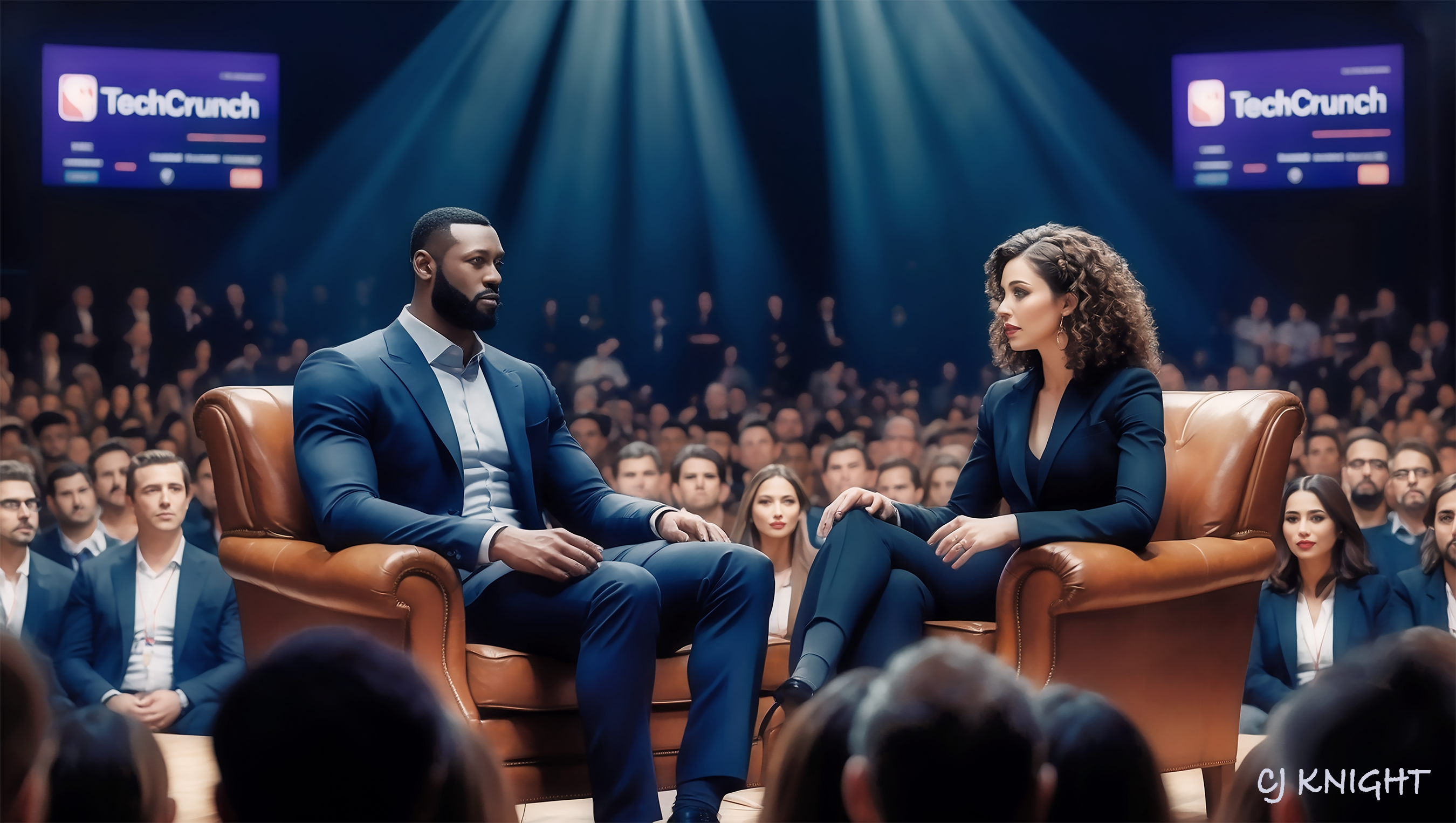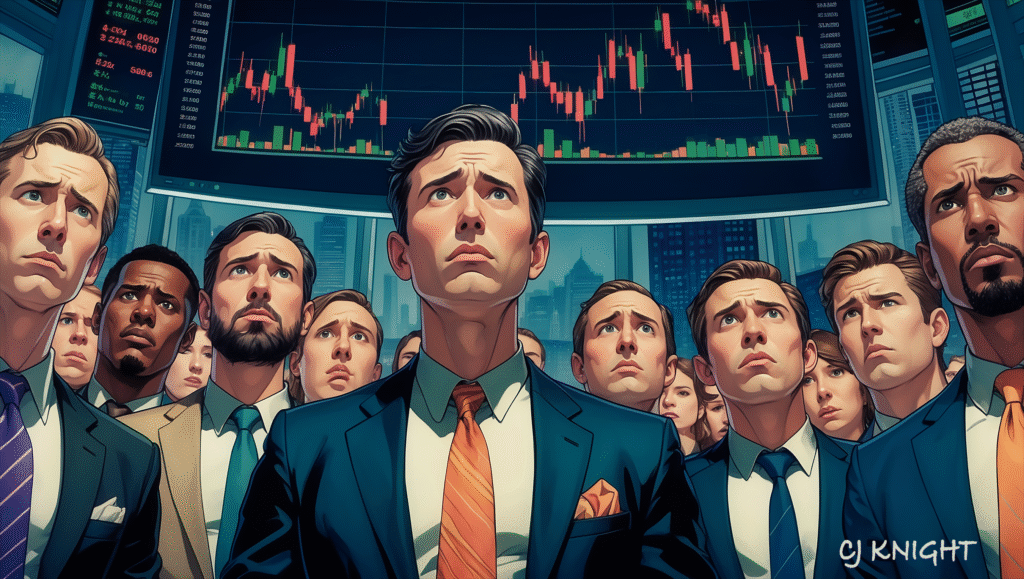At the heart of Silicon Valley’s biggest annual gathering for startups and VCs, the cracks in tech’s foundation became impossible to ignore.
The closing fireside chat at TechCrunch Disrupt 2025 on October 26th delivered an unintentionally perfect metaphor for the tech industry’s current moment. There sat Tristan Thompson, NBA champion turned crypto evangelist, earnestly pitching his “Uplift” initiative as “the Uber of internet access” for underserved communities. The moderator didn’t miss a beat.
Speaking of Uber, she said, her skepticism sharp enough to cut through the Moscone West’s recycled air, the drivers I talk to aren’t exactly thrilled about paying for their own cars, maintenance, and gas while struggling to make minimum wage.
She paused, letting that sink in before pivoting to Thompson’s other venture: his role as global ambassador for Sportsbet.io, a crypto-first sports betting platform. Her concern about sports betting’s documented negative impact on men was equally pointed.
It was a rare moment of unvarnished reality at a conference where optimism usually reigns supreme. And it set the perfect tone for announcing this year’s Startup Battlefield winner: not another AI chatbot or prediction market, but Glīd — a logistics company solving the decidedly unglamorous problem of moving shipping containers from ports to railheads more efficiently.
After three days navigating Disrupt alongside the team from GigU, the Brazilian-born app/platform helping gig drivers reclaim profitability in an increasingly exploitative economy, that exchange felt less like a sidebar and more like the main story.
The future of tech, it turns out, might depend less on how much artificial intelligence we can build and more on whether we remember that real intelligence — the human kind — still matters.
The AI Bubble Everyone’s Whispering About
Walk through Disrupt’s Expo Hall, and you’d think artificial intelligence had already solved every problem humanity faces. Booth after booth promised AI-powered solutions for everything from content creation to cancer detection. The phrase “powered by AI” became this year’s “blockchain-enabled” — a reflexive addition to every pitch deck, whether warranted or not.
But beneath the surface enthusiasm, a different conversation was happening:
Veteran investors huddled in corners, drawing uncomfortable parallels between 2025’s AI infrastructure boom and 2008’s financial collapse. The numbers are staggering: global spending on AI technology is projected to hit $375 billion by the end of 2025 and half a trillion dollars in 2026, with three-quarters of S&P 500 gains since ChatGPT’s launch coming from AI-related stocks.
Here’s where it gets interesting — or alarming, depending on your perspective. Nvidia, the chipmaker underlying the AI boom, recently became the first company in history valued at $5 trillion. To put that in context: multiplying Ford’s current market cap 94 times wouldn’t quite reach Nvidia’s valuation. Yet 20 years ago, Ford was worth nearly triple what Nvidia was.
America has become a “Nvidia-state,” per The Atlantic, with AI-related spending now contributing more to GDP growth than all consumer spending combined.
During the first half of 2025, those AI expenditures accounted for 92 percent of GDP growth. That’s not diversification — that’s dependency.
The whispers of “bubble” have risen to a chorus. Satellite photos of places like New Carlisle, Indiana, show farmland transformed into massive data center campuses practically overnight — seven rectangular buildings with 23 more planned, demanding more power than two Atlantas.
OpenAI has announced plans to build at least 30 gigawatts worth of data centers, more power than all of New England requires on even the hottest day.
A recent McKinsey & Company report found that nearly 80 percent of companies using AI discovered the technology had no significant impact on their bottom line. Meanwhile, OpenAI likely made $4 billion last year but lost $5 billion, and Microsoft’s investments in OpenAI resulted in losses totaling more than $3 billion in just one quarter.
Yale professor and financial analyst observers have drawn explicit parallels to the subprime mortgage crisis. Private equity firms are raising money for massive data centers by essentially issuing bonds backed by tech companies’ rent, packaging multiple data center leases into securities sorted into “tranches” based on risk of default — a structure eerily reminiscent of the repackaged mortgages that precipitated the 2008 collapse.
The Refreshing Reality Check
Against this backdrop of AI maximalism, TechCrunch Disrupt’s Startup Battlefield offered something increasingly rare in Silicon Valley: practical innovation solving actual problems.
Glīd, the competition’s winner, beat out 199 other companies with its GliderM — a hybrid-electric vehicle that moves 20-foot shipping containers directly from ships to rail without forklifts or hostler trucks. It’s not sexy. It won’t generate viral TikToks. But it addresses real inefficiencies in global supply chains that cost billions annually.
The runner-up was equally grounded in reality. Biotech company Nephrogen uses AI and advanced screening to develop a delivery system for gene-editing medicines targeting kidney cells, achieving efficiency 100 times better than FDA-approved methods. Founder Demetri Maxim, who lives with polycystic kidney disease, plans to participate in clinical studies himself.
Other standouts included MacroCycle Technologies, making recycled plastic as inexpensive as virgin material through innovative polymer chemistry, and Charter Space, essentially building a fintech company for the space industry by streamlining spacecraft insurance underwriting.
None of these companies led with “AI-powered” in their pitches. Several use artificial intelligence as a tool, not as the product itself. The distinction matters.
Brynn Putnam returned to the Disrupt stage seven years after launching Mirror, which she sold to Lululemon for $500 million. Her new venture, Board, is a 24-inch gaming console housed in a wood-finish frame that recognizes touches, gestures, and physical objects — bridging digital and physical play for families. “Play is just universal,” Putnam said. “It’s this universal language that connects us and brings us together.”
Netflix CTO Elizabeth Stone discussed the company’s experiments with vertical video, careful to distinguish their approach from TikTok. “We think there’s a certain type of entertainment that’s especially valuable to our members, and we really want to be focused there, versus trying to be all things at every moment,” she explained. It was a refreshing acknowledgment that not every platform needs to chase every trend.
The Pro-Human Algorithm
My week at TechCrunch Disrupt carried additional resonance because I was there with GigU, the app that’s become a flashpoint in the broader debate about who benefits from the gig economy. The company’s journey mirrors many of the tensions playing out across tech.
After launching in Brazil last September, and expanding to the U.S. in May, GigU now has more than 1,250,000 downloads with about 30 percent of app users converting to its paid subscription. Its flagship “Cherry Picker” feature uses algorithms to help drivers increase daily profits by up to 30 percent by showing potential earnings before they accept rides through an intuitive color-coded system: green for profitable rides, yellow for acceptable options, red for trips to avoid.
The concept is deceptively simple. Platform companies use sophisticated algorithms to maximize their profits, often at drivers’ expense. Average gig driver pay has dropped more than 20 percent since 2023 due to opaque dynamic pricing. GigU gives drivers their own algorithm — one that works for them instead of against them.
Unsurprisingly, this didn’t sit well with Uber. The platform giant took GigU to court in Brazil in 2023, claiming the app illegally obtained and stored confidential data. GigU countered that it simply reads information already visible on screen and performs calculations to help drivers make better decisions.
In August 2023, Uber lost its injunction in a unanimous 3-0 appeals court decision. The publicity actually accelerated GigU’s growth.
The conflict escalated when GigU filed an antitrust complaint with CADE, Brazil’s equivalent of the FTC. In February 2025, CADE launched an investigation into Uber’s business practices, ordering the company to provide data on operations and driver bans dating back to 2020.
Walking Disrupt’s halls with the GigU team, the contrasts were stark. While stages featured discussions about AI agents and prediction markets, millions of actual humans were navigating an economy increasingly designed to extract maximum value from their labor while providing minimal transparency about compensation.
The Waymo discussion on the Disrupt Stage provided another telling moment:
Co-CEO Tekedra Mawakana addressed the inevitable question about autonomous vehicles causing deaths with remarkable candor. “We don’t say ‘whether.’ We say ‘when,'” she said. “I think that society will [accept it]. The challenge is making sure that society has a high enough bar on safety that companies are held to.”
It’s a utilitarian argument: if Waymo’s cars are safer than human drivers overall, their widespread use would be a net good, even if they cause some accidents. But it also reveals an assumption baked into much of Silicon Valley’s thinking — that technological progress is an inexorable force to which society must adapt, rather than a set of choices we make collectively about the future we want.
What Happens When the AI Bubble Bursts
History offers uncomfortable precedents: rapid construction of canals, railroads, and fiber-optic cables during the dot-com bubble all created frenzies of hype, investment, and financial speculation that crashed markets. All eventually transformed the world — but not before causing significant economic pain.
The current AI infrastructure build-out shares troubling characteristics with those past bubbles. Data centers deteriorate rapidly, and many chips inside become obsolete within a few years when companies release new hardware, making the returns on scaling up chatbots increasingly diminished as improvements from each new model become smaller.
If tech stocks fall because AI companies fail to deliver on promises, highly leveraged hedge funds invested in these companies could be forced into fire sales, creating a vicious cycle that spreads to pension funds, mutual funds, insurance companies, and everyday investors.
Non-tech stocks would plummet too, and if the damage knocked down private equity firms managing trillions in assets, we could face another major crash.
Columbia Business School professor Len Sherman, whose research on algorithmic pricing I’ve covered, has documented how platforms like Uber have extracted an estimated $3.9 billion annually from U.S. drivers through opaque pricing mechanisms. It’s the same extractive logic that drives the AI boom: concentrate power and profits at the top while distributing risks and costs downward.
The circular investment patterns have become almost comical in their complexity. OpenAI agreed to pay Oracle $300 billion for computing capacity. Oracle is paying Nvidia tens of billions for chips to install in OpenAI’s data centers. Nvidia has agreed to invest up to $100 billion in OpenAI as it deploys Nvidia chips. One software engineer referred to illustrations of these relationships as “the technocapital hyperobject at the end of time.”
Maybe it all works out. Maybe OpenAI or Anthropic achieves superintelligence and, as Bloomberg Opinion columnist Matt Levine quipped, can “create God and then ask it for money.”
But that outcome presents its own challenges. If AI companies deliver on their massive investments, they’ll produce technology so capable it could wipe out countless jobs before humans have time to adapt — if we can adapt at all.
Returning to First Principles
San Francisco Mayor Daniel Lurie‘s appearance at Disrupt felt symbolic. The newly elected mayor is working to weave innovation back into the city’s future after pandemic-era fractures between City Hall and the tech community. His presence suggested a recognition that for San Francisco to remain relevant, it needs to remember why it became a technology capital in the first place.
It wasn’t because of hype cycles or speculative bubbles. It was because of people solving real problems with elegant solutions. It was the spirit that built Dropbox, Discord, Cloudflare, and Mint — all past Startup Battlefield winners. Companies that, notably, didn’t promise to revolutionize everything immediately. They just made specific things work better.
Vinod Khosla, speaking earlier in the conference, touched on this tension. While he defended AI’s energy consumption and expressed optimism about geothermal solutions, he also offered a wry observation about the current administration: “The only thing I will say is this administration won’t last forever.” The grin suggested he was thinking about more than just politics.
The 10,000 people who filled Moscone West weren’t just there for the hype. They came for the connections, the knowledge exchange, the chance encounters that might spark genuine innovation. The 200 startups exhibiting, the 2,000 curated networking meetings, the roundtables and breakout sessions — these represented technology’s democratic promise, not its oligarchic reality.
GigU’s presence at Disrupt, despite ongoing legal battles with Uber, embodied this tension perfectly. The company exists because drivers themselves asked for tools to help them make better decisions. It grew not through venture capital hype but through solving actual problems for actual people. Its expansion to the U.S. market comes as economic pressures push more Americans into gig work — a trend likely to accelerate given current political and economic instability.
The Question Nobody’s Asking
Here’s what struck me most about TechCrunch Disrupt 2025: the most important conversations happened in the spaces between the programmed sessions. In those moments, the facade cracked enough to reveal the uncertainty beneath.
Investors quietly admitting they don’t know where AI is actually heading. Founders confessing that the pressure to add “AI-powered” to every feature feels more like cargo-cult thinking than innovation. Drivers sharing stories about deteriorating conditions as platforms prioritize growth metrics over human sustainability.
The Thompson exchange about his “Uber of internet access” would be funny if it wasn’t so revealing. The Uber model — concentrate control, externalize costs, extract maximum value through algorithmic opacity — has become tech’s default template. That we’re now applying it to internet access for underserved communities while simultaneously promoting crypto-based sports betting suggests we’ve lost the plot entirely.
Twenty-two states are in or near recession despite a roaring stock market, U.S. manufacturing is in decline, and job openings have fallen even as data center construction props up certain sectors. The disconnect between market performance and economic reality grows more pronounced daily.
Glīd’s victory offered a different vision: technology in service of efficiency rather than extraction. Nephrogen’s approach suggested AI can be a tool rather than an end unto itself. Board’s focus on bringing people together physically for fun reminded us that not all innovation needs to be virtual.
The real disruption at Disrupt 2025 wasn’t on any stage. It was the quiet recognition, spreading through conversations and knowing glances, that we might be approaching an inflection point. The question isn’t whether the AI bubble will burst — history suggests all bubbles eventually do. The question is what we build afterward, and whether we’ll finally learn that sustainable innovation serves people rather than treating them as resources to be optimized.
Walking out of Moscone West for the last time, passing the endless booths and the networking clusters, I thought about the drivers who’ll never attend a conference like this but whose labor enables much of what happens here. The gig workers who deliver food to the Expo Hall. The rideshare drivers who ferry attendees between sessions and after-parties. The essential workers whose algorithmic management is celebrated as innovation rather than questioned as exploitation.
The future of tech won’t be determined by how many trillions we can pour into data centers or how sophisticated our AI models become. It will be determined by whether we remember that technology’s purpose is to empower people, not to automate them away or extract maximum value from their labor. That’s not a technical problem. It’s a human one.
And human problems, it turns out, still require human solutions.



